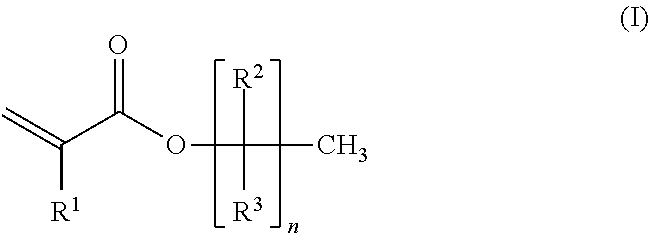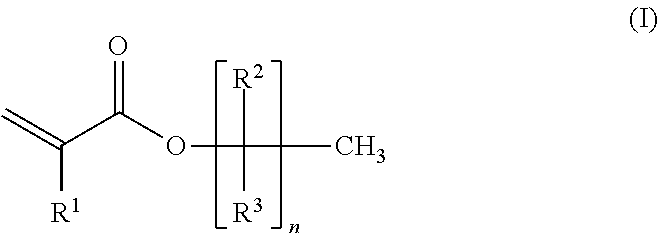Cationic pressure sensitive adhesive UV cured by medium mercury bulbs
a technology of mercury bulbs and adhesives, applied in the direction of adhesive types, non-macromolecular adhesive additives, film/foil adhesives, etc., can solve the problems of adhesives without cohesive strength, adhesives that are permanently tacky at room temperature, and are easily coated on substrates, etc., to achieve the effect of improving the cationic uv-curable pressure sensitive acrylic adhesives
- Summary
- Abstract
- Description
- Claims
- Application Information
AI Technical Summary
Benefits of technology
Problems solved by technology
Method used
Image
Examples
example 1 (comparative)
an Acrylic Polymer Containing 2-Ethylhexylacrylate
[0126]Preparation of the UV Curable Polymer:
[0127]A four-neck 1 L round-bottom polymerization flask was equipped with a thermometer connected to a temperature control device, a condenser, an overhead mechanical stirrer, two addition funnels, and nitrogen inlet / outlet. The set-up was purged with nitrogen gas for 15 min. A mixture of the following monomers was prepared: 2-ethylhexylacrylate (2-EHA, 99.8 g), methyl acrylate (MA, 96.2 g), 1-acrylomethyl-3,4-cyclohexene epoxide (M100, 1.0 g). To one of the funnels was charged 160 g of the monomer mixture. To another funnel was charged the initiator 2,2′-azobis-(2-methyl propionitrile) (AIBN, 0.5 g) and ethyl acetate (60 mL). To the polymerization flask was charged the remaining monomer mix (40 g), initiator AIBN (0.27 g), and ethyl acetate (100 mL). The mixture was heated to vigorous reflux (76 to 80° C.) and held for 15 minutes. Then, the monomer mix in the funnel was added continuously ...
example 2
sing Only Butyl and Methyl Acrylate in the Acrylic Polymer
[0130]Preparation of the UV curable polymer: identical to the polymer prepared in example 1, with the difference that the 2-ethylhexyl acrylate was replaced with butyl acrylate. The performance of this polymer can be seen in table 2 below. Most important are the rolling ball values for the 2 different curing conditions: AT 20 mJ UV-C: 20 and 21 cm for the both sides. At the higher curing dose: 26 and 28 cm, which is not a significant difference.
[0131]
TABLE 2Performance measurements of the tackified polymer using only butyl and methyl acrylateCoating methodunitdirectdirecttransfertransferCoating weight: 65 gsm65 gsm65 gsm65 gsm65 g / m2Applied Dose 20 40 20 40 (mJ UV-C / cm2)mJ / cm2mJ / cm2mJ / cm2mJ / cm2Measured sideCoatingCoatingCoatingCoatingconditioncondition conditioncondition1: light2: light 1: dark2: darksidesidesidesideAFERA 4001 after N / inch 9.6 AF 9.6 AF11.511.5 10 min. on steelAF / CFAF / CFAFERA 4001 after N / inch13.4 AF12.6 AF15...
PUM
| Property | Measurement | Unit |
|---|---|---|
| Tg | aaaaa | aaaaa |
| thickness | aaaaa | aaaaa |
| temperatures | aaaaa | aaaaa |
Abstract
Description
Claims
Application Information
 Login to View More
Login to View More - R&D
- Intellectual Property
- Life Sciences
- Materials
- Tech Scout
- Unparalleled Data Quality
- Higher Quality Content
- 60% Fewer Hallucinations
Browse by: Latest US Patents, China's latest patents, Technical Efficacy Thesaurus, Application Domain, Technology Topic, Popular Technical Reports.
© 2025 PatSnap. All rights reserved.Legal|Privacy policy|Modern Slavery Act Transparency Statement|Sitemap|About US| Contact US: help@patsnap.com



